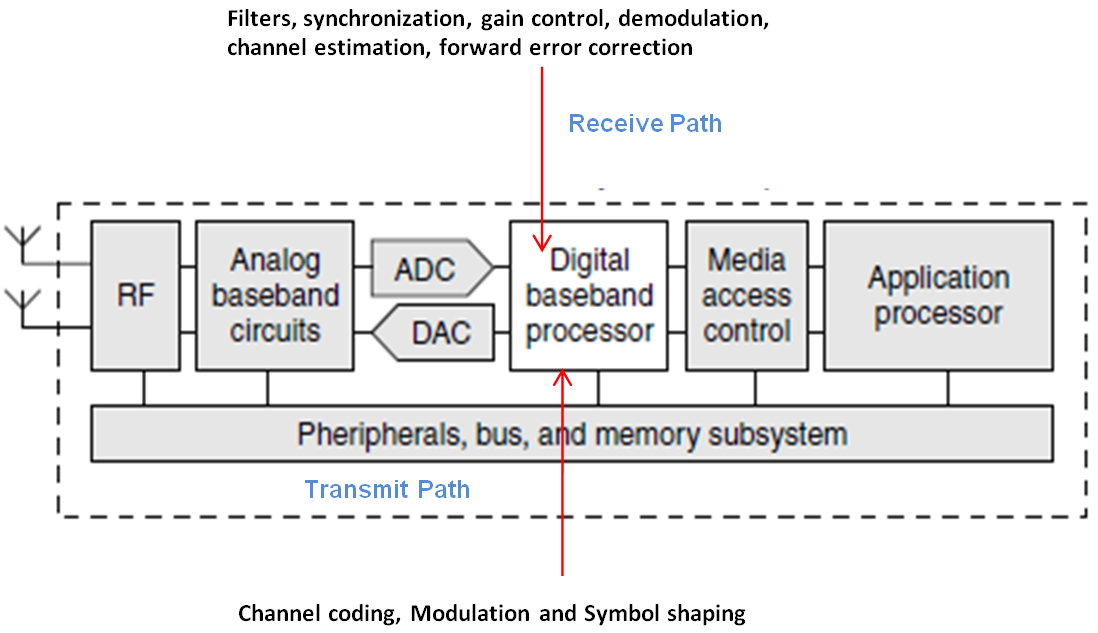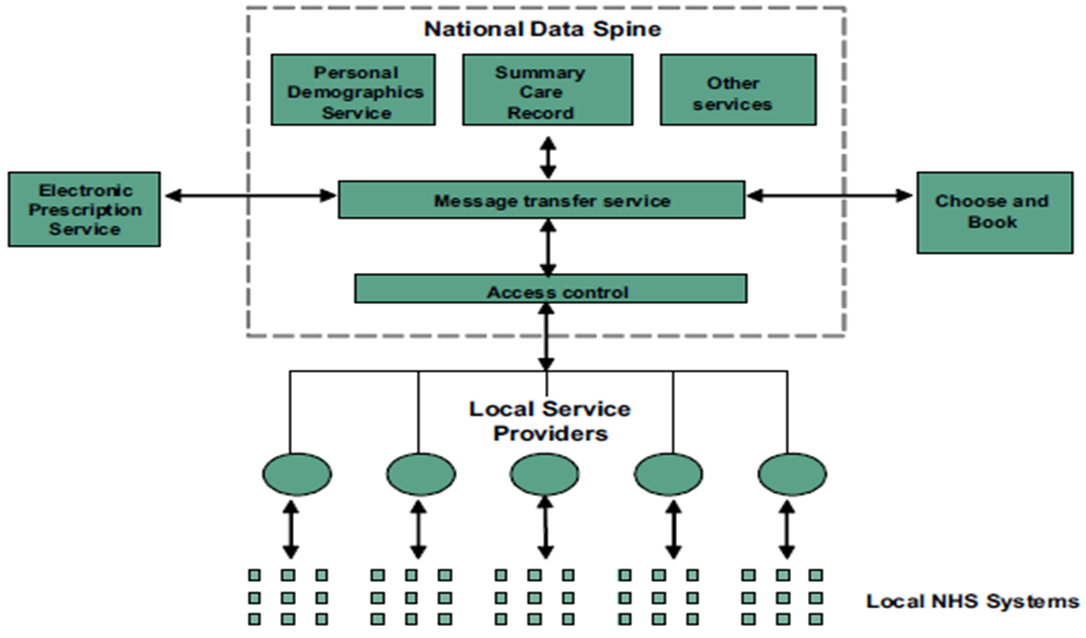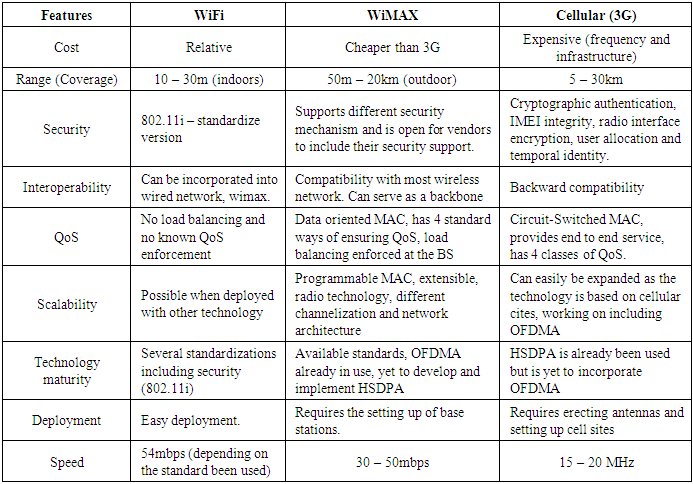-
Paper Information
- Paper Submission
-
Journal Information
- About This Journal
- Editorial Board
- Current Issue
- Archive
- Author Guidelines
- Contact Us
International Journal of Networks and Communications
p-ISSN: 2168-4936 e-ISSN: 2168-4944
2017; 7(3): 55-62
doi:10.5923/j.ijnc.20170703.02

WiMAX for Online Service Transmission
Ibuomo R. Tebepah
Software Engineering Department, Linnet Paul Innovative Institute, Yenagoa, Nigeria
Correspondence to: Ibuomo R. Tebepah, Software Engineering Department, Linnet Paul Innovative Institute, Yenagoa, Nigeria.
| Email: |  |
Copyright © 2017 Scientific & Academic Publishing. All Rights Reserved.
This work is licensed under the Creative Commons Attribution International License (CC BY).
http://creativecommons.org/licenses/by/4.0/

One of the most challenging in today’s technology based world is working on real time for almost everything, an interrupted and high data speed is required. This paper attempt to proffer WiMAX as the best option amidst all other technology for wireless network deployment. A scenario was created, and after a comparative analysis, mobile WiMAX leveraging on the WiMAX Broadband Service (WBS) is preferred and used to proffer a solution.
Keywords: Base Station, WiMAX Broadband Station
Cite this paper: Ibuomo R. Tebepah, WiMAX for Online Service Transmission, International Journal of Networks and Communications, Vol. 7 No. 3, 2017, pp. 55-62. doi: 10.5923/j.ijnc.20170703.02.
Article Outline
1. Introduction
- With the rapid increase in computer devices such as laptops, personal computers, mobile devices and other intelligent devices, our lives had been totally networked and it is almost impossible to exist without it. Information is required at every point in time – personal details for bank transaction, business information for effective distribution of products and services, travel guide details for security, bus pass readers etc.Computer networking is concerned with communication between and amongst all intelligence devices [1] which may be widely apart (www, internet) or within same vicinity (LAN, Bluetooth). The main purpose is for information and resource sharing which has become essential in our world today to save cost – money, time and energy.This report will essentially provide a general over of networking technologies available, the types of device used, mode of transmission and the different areas of implementation. It will present analysis of online systems, its operations – referring to how online systems are implemented and managed in today’s world with examples. It will also outline a detailed explanation of WiMAX which is the focal point and how it can / could be used in transmitting online services that are essential in our daily lives of fast track.
2. Networking Technologies
- Networking technology in general term is the application of networking architecture within an organizational system, applying the principles of networking-interconnecting systems within the establishment. The e-learning system in colleges and universities today is based on it. Network monitoring devices are used to collect data for authentication and structured in a centralized manner for effective management, online resource availability and to facilitate the front end of learning [2]. The network technology an organization implement depends on the network policy in place [3]. The policy defines the priorities – measuring performance against speed, data security, availability, reliability, quality of service and above all cost. In a broad approach, network technology has 2 distinct categories – the traditional and the active network [4]. The traditional network transmits data passively with no direct input from the user in the course of transmission while the active network provides room for user program injection. Thus users and vendors are at liberty to introduce programs runable in the network. As much as the active network speeds up the transmission of data, it also have a security breach, any person with access (legally or hacked) can inject a program.The knowledge of this has rapidly aided the development of networking technologies from the wired (the use of cables) to wireless (radio frequencies) and standardization of technologies. The focus of this report is on wireless.Wired network involves the use of traditional cables, digital subscriber line, Ethernet and optic fiber. It is efficient, reliable and has high bandwidth. However, it is expensive to deploy and maintain for carriers. Also, in remote and rural areas, carriers are not willing to build the necessary infrastructures; this explains the slow pace of internet deployment in these areas.The wireless networking technology is based on radio frequency (RF) which dates back to the 1970s [5] and has developed over the years with different technological reforms ranging from the architecture, the devices and how frequencies are distributed during data transmission. Frequencies used in transmission are usually regulated by the IEEE which also establishes standardization for wireless devices enabling coexistence and interoperability amongst such devices. Unlike its cable counterpart that has low interference, wireless transmission has high rate of interference which constantly distorts signals during transmission. The level of interference tolerance is greatly determined by the technology used, such as the way in which frequencies are distributed, channelization, the range, the line of sight and the general mechanisms of the technology. Just as in the case of wired network, the wireless network has the logical and the physical architecture.i. The physical comprises of the various topologies such as point to point, mesh, star, point to multiple etc [5].ii. The logical architecture is made up of the different layers such as network, data link which actually coordinates the signal / data transmission.
3. Examples of Wireless Technologies
- i. 3G Technology – this uses satellite radio channel, antenna and the cellular system for communication – transmission of signals. Within the ambits of this is modulation technique, multiplexing technique, signal propagation and spread spectrum.ii. Bluetooth – is an IEEE 802.15 that operates in a short range, uses low power and cost less compare to other forms of technologies [6].iii. Infrared – this uses line of sight and diffuse light reflected in objects (walls, furniture etc), and exist between sender and receiver [7].iv. WiFi – is wireless fidelity, 802.11. It is designed to operate within indoors and easily incorporated into wired LANS. It is a technology that easily serves the front end of a network.v. Others are WiMAX (which will be discussed later), HIPPERMAN, WiBro etc.
4. Wireless Concept Definition
- Signals – the physical representation of data or information. Communication is done through the sending and receiving of signals.Signal propagation – has 3 elements: range of transmission, range of detection and interference range [7].Multiplexing – this is the description of how several users can share a medium to send and receive data with minimal or no interference.Modulation – this is the wave that shows how signal looks like during transmission. Different things can the discovered by observing the sine wave curve such as the strength of the signal.Frequency – this is the repetition of wave.Channel – splitted or slice bandwidth into small sections.Features of Wireless NetworkŸ Wireless network is not synonymous with mobility although it has element of mobility.Ÿ Has high rate of interference. However, the level of interference varies from technology to technologyŸ Can easily be implemented in rural and war turned zones where infrastructures had been destroyed.Ÿ Have varieties of technologies to choose from with standardizations.Ÿ High level of security as authentication is required at every instance of communication.Ÿ Convergence and extensibleŸ Cost saving
5. The WiMAX Technology
- Broadband wireless access technologies have been available for a while and the primary aim of all the technologies was to provide a high data rate transmission but wirelessly connected to fixed and stationary sites [8]. Examples of such applications are the building to building bridging, access / connection to remote sites etc.Just like every proprietary technical solution, there were lots of problems such as poor interoperability and compatibility amongst product, high scale economy, readily unavailability, deployment issues etc.WiMAX belongs to the IEEE 802.16 WMAN technology family and is referred to as Worldwide Interoperability for Microwave Access. It is intended at the following:Ÿ To provide a standard broadband accessŸ Make it affordableŸ Revolutionized broadband communication in developed countries and at same time bridge digital divide in third world countries [8]Ÿ Improve quality of life which will eventually lead to large economic of scale.The summary is to make wireless broadband access available anywhere, anytime and run on any device that has some form of intelligence. These intentions characterized the basic features of WiMAX, which;Ÿ Flexibility, extensible and robustnessŸ Improved performanceŸ End to end IP based supportŸ Secure mobilityŸ Broadband speeds for voice, data and videoŸ Adaptive ModulationŸ Use of OFDMAŸ Supports FDD and TDDŸ Shares data up to 70mbps and 3-5 mile coverageŸ Expanded capability on the IEEE specifications.
6. The Architecture
- i. The Physical Architectureii. Logical Architecture6.1. The Physical Architecture: This comprises the physical connection between the base stations (BS), the subscriber station (SS) and the World Wide Web / internet. See the figure below
 | Figure 1 [9] |
 | Figure 2 [10] |
 | Figure 3 |
7. Current Issues on WiMAX and Applications
- This section deals with brief summaries of researches going in WiMAX technology and the various areas where it is been applied.WiMAX backhaul for environmental monitoring is a research work that summarizes the possibilities of using WiMAX as a backbone for monitoring the environment [11], using sensor to collect data. In this case, WiMAX is deployed as a backbone.Dynamic System-Level Simulation of Dynamic Frequency Planing for Real Time Services in WiMAX Networks introduces and reviews the use of WiMAX analyzing the performance several other networks [12]. In other to achieve the desired result, WiMAX simulation was used in real time services such as voice over IP and video.WiMAX is been considered as a suitable wireless network technology for dynamic spectrum access in heterogeneous networking environment [13]. It is proposed that a cross layer PHY-MAC using certain algorithm will allow WiMAX to access spectrum, maximizing the bandwidth.With live streaming of videos been a common place on the internet, buffering is becoming an issue. Several solutions are recommended and some are been implemented, yet researchers are currently looking at how to reduce buffering and waiting time on WiMAX systems [14]. The whole idea is to provide video on demand and improve draw back mechanisms by using the reminder arrangement broadcasting to reduce the required buffer and hybrid RAB to shorten the waiting time.The utilization of sleep-mode to save processing power and redirect it to where is required is been propounded by using certain algorithm (periodic on-off scheme and aperiodic on-off) in WiMAX [15]. It was observed that using PS and AS effectively and efficiently scheduled packets in real time communication in WiMAX, thereby saving processing power but then it was been utilized by another within same system.
8. Online Service Transmission
- An Online System is a standby system which is connected and managed at all times by an intelligent device (pc, mobile phone etc) that receives and disseminates data [16]. It is not same as website even though websites are usually online. Such a system could be hardware or software that runs in the system. Whatever the case, it has to be readily available for retrieving data as at when needed.
8.1. Problem Assumption
- A medical doctor (GP) wants x-ray result of his patients sent to him as soon as it has been taken for prompt medication, easy transfer of reports to a specialist and control purposes. He lives about 100miles away from the city, the conventional method is postage which sometimes comes late and is just a summary of the result, he wants details and in its original content.
8.2. Proposed Solution
- Factors to considerŸ ReliabilityŸ Security – data protection policyŸ CostŸ Speed – time frameŸ CoverageŸ Architecture Ÿ Existing system incorporationThis requires interconnection between the GP’s office (hospital) to the radiologist office (hospital). The use of wired network is not feasible due to the cost, architecture and already existing LAN in both hospitals. The use of wireless on the other hand is visible but which of the wireless technology can be deployed?
9. Comparative Analysis of Wireless Technologies
- WiFi – Wireless Fidelity (IEEE 802.11) is basically for indoors and limited in it coverage (about 10-30m). It is suitable for short distance connection (Local Area Network).Cellular – This includes GSM and CDMA with complex architecture because several antennas and cell base station had to be erected for effective transmission. It is also relatively expensive but very high bandwidth.WiMAX – IEEE 802.16, belong to WMAN family. It is not an extremist technology. It can be deployed in different situation and also extensible to accommodate expansion and at same time serve as the backhaul for WiFi. Relative cost effective compared to Cellular technology. See detailed comparison in the table below.
|
10. Implementation
- In implementing WiMAX to solve the assumed problem, there are basically 2 levels in which patient’s health record details are required – the local detailed clinic (use by the healthcare communities (GP) ) and the national summary clinical record(to support for emergency, those that falls ill while away). See diagram below.
 | Figure 4 [17] |
 | Figure 5 |
11. WiMAX Performance Analyses
- Quality of Service: WiMAX maintains QoS by defining certain requirements such as admission control and proper scheduling. It determines when a call is put through or accepted depending if the call QoS is supported or not. The IEEE 802.16 also predefined 4 basic standards: unsolicited grant service, best effort, real-time polling service and nonreal-time polling service [10], and bandwidth is given based on request and granted per connection or per SS (GPSS). There will be bandwidth availability for both transmission and reception on each subscriber.Security: Since WiMAX is open and support different mechanisms, only devices from reliable vendors with additional security features will be purchase. Also, the system administrator can implement other levels of securities aside the ones already provided by the technology and the vendor.Interoperability: Already existing LAN can be easily incorporated into the new network enabling server – client environment with the WiMAX serving as the backhaul. This minimizing fresh or total overhauling of the entire system.Speed: The available bandwidth is sufficient for data transmission and the fact the technology could be extended to meet increased demand makes it suitable and reliable.WiMAX supports high data rate, high sector throughput, multiple handover mechanism and power saving mechanism for mobile advances [18]. The low latency supports real time application such as live video streaming.The distance coverage ranges from 7-10km and can be extended 50km when omni directional antenna is used [19].
12. Conclusions
- WiMAX based on the IEEE 802.16e standard is fast becoming the alternative solution to DSL for the Broadband Wireless Access (BWA) [20], with its improved handover hopping system – determining the best handover with base station (BS) while in mobility (MS). [21]. WiMAX despite its challenges, is most preferred in an online even real time service transmission. It has been able to handle mobility and availability with speed.Off cause, we have the politics of technology deployment, and will always be there just like the right and the left wing. However, cost is a major determinant as well as the question ‘can the technology do the job?’The researcher’s duty is to objectively look at each and propose a solution which is what this report is all about.In essence, requirements set the basis for technology deployment and in areas of conflict trade-offs are made to accommodate or improve performance, and in this case, WiMAX mobile does the job well.
 Abstract
Abstract Reference
Reference Full-Text PDF
Full-Text PDF Full-text HTML
Full-text HTML